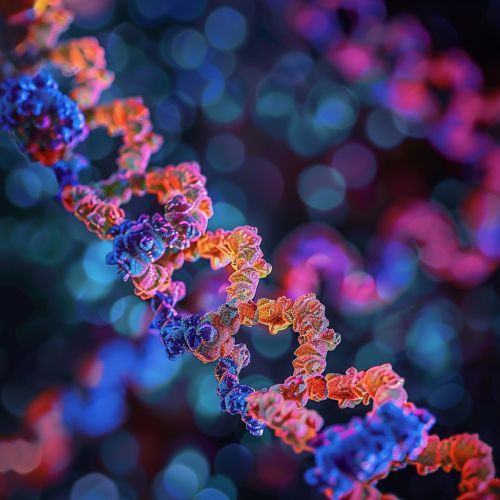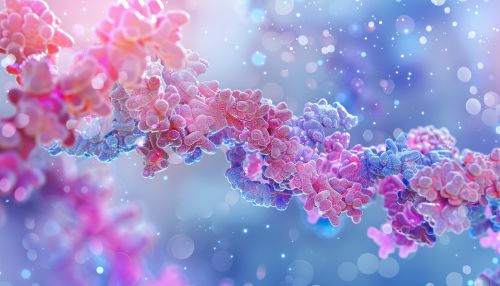Phosphorylase kinase: Difference between revisions
(Created page with "== Phosphorylase Kinase == Phosphorylase kinase is a crucial enzyme in the regulation of glycogen metabolism. It plays a pivotal role in the activation of glycogen phosphorylase, which in turn catalyzes the breakdown of glycogen into glucose-1-phosphate. This enzyme is a key component in the glycogenolysis pathway, which is essential for maintaining blood glucose levels, particularly during periods of fasting or intense physical activity. <div class='only_on_de...") |
No edit summary |
||
| Line 3: | Line 3: | ||
Phosphorylase kinase is a crucial enzyme in the regulation of glycogen metabolism. It plays a pivotal role in the activation of [[glycogen phosphorylase]], which in turn catalyzes the breakdown of glycogen into glucose-1-phosphate. This enzyme is a key component in the [[glycogenolysis]] pathway, which is essential for maintaining blood glucose levels, particularly during periods of fasting or intense physical activity. | Phosphorylase kinase is a crucial enzyme in the regulation of glycogen metabolism. It plays a pivotal role in the activation of [[glycogen phosphorylase]], which in turn catalyzes the breakdown of glycogen into glucose-1-phosphate. This enzyme is a key component in the [[glycogenolysis]] pathway, which is essential for maintaining blood glucose levels, particularly during periods of fasting or intense physical activity. | ||
[[Image:Detail-91229.jpg|thumb|center|High-resolution image of phosphorylase kinase structure, showing its quaternary structure with alpha, beta, gamma, and delta subunits.|class=only_on_mobile]] | |||
[[Image:Detail-91230.jpg|thumb|center|High-resolution image of phosphorylase kinase structure, showing its quaternary structure with alpha, beta, gamma, and delta subunits.|class=only_on_desktop]] | |||
=== Structure === | === Structure === | ||
Latest revision as of 06:01, 22 June 2024
Phosphorylase Kinase
Phosphorylase kinase is a crucial enzyme in the regulation of glycogen metabolism. It plays a pivotal role in the activation of glycogen phosphorylase, which in turn catalyzes the breakdown of glycogen into glucose-1-phosphate. This enzyme is a key component in the glycogenolysis pathway, which is essential for maintaining blood glucose levels, particularly during periods of fasting or intense physical activity.


Structure
Phosphorylase kinase is a large, multi-subunit enzyme complex composed of four different types of subunits: alpha (α), beta (β), gamma (γ), and delta (δ). The enzyme exists as a hexadecamer, meaning it has 16 subunits in total, arranged in an (αβγδ)₄ configuration. Each subunit plays a specific role in the enzyme's function:
- **Alpha (α) Subunit**: The α subunit is involved in the regulation of the enzyme's activity. It contains sites for phosphorylation by protein kinase A (PKA) and other kinases, which modulate the enzyme's activity.
- **Beta (β) Subunit**: Similar to the α subunit, the β subunit also contains phosphorylation sites that are crucial for the regulation of phosphorylase kinase activity.
- **Gamma (γ) Subunit**: The γ subunit is the catalytic core of the enzyme. It contains the active site where the phosphorylation of glycogen phosphorylase occurs.
- **Delta (δ) Subunit**: The δ subunit is a calmodulin protein, which binds calcium ions. The binding of calcium to the δ subunit is essential for the activation of phosphorylase kinase.
Mechanism of Activation
Phosphorylase kinase is activated through a combination of phosphorylation and calcium binding. The enzyme is regulated by both hormonal signals and intracellular calcium levels:
- **Phosphorylation**: Hormones such as epinephrine and glucagon trigger the activation of PKA, which phosphorylates the α and β subunits of phosphorylase kinase. This phosphorylation induces a conformational change that activates the enzyme.
- **Calcium Binding**: During muscle contraction or other cellular activities that increase intracellular calcium levels, calcium ions bind to the δ subunit (calmodulin). This binding further activates phosphorylase kinase by enhancing its catalytic activity.
The dual regulation by phosphorylation and calcium binding ensures that phosphorylase kinase is precisely controlled in response to the body's metabolic needs.
Function
The primary function of phosphorylase kinase is to activate glycogen phosphorylase, the enzyme responsible for glycogen breakdown. Glycogen phosphorylase exists in two forms: an active form (phosphorylase a) and an inactive form (phosphorylase b). Phosphorylase kinase catalyzes the phosphorylation of phosphorylase b to convert it into the active phosphorylase a.
This activation is a critical step in glycogenolysis, allowing the rapid mobilization of glucose from glycogen stores. This process is particularly important in liver and muscle tissues:
- **Liver**: In the liver, glycogenolysis provides glucose to maintain blood glucose levels, especially during fasting or between meals.
- **Muscle**: In skeletal muscle, glycogenolysis supplies glucose for energy production during muscle contraction and physical activity.
Regulation
The activity of phosphorylase kinase is tightly regulated by several mechanisms to ensure proper glycogen metabolism:
- **Hormonal Regulation**: Hormones such as epinephrine and glucagon activate PKA, which phosphorylates and activates phosphorylase kinase. Conversely, insulin promotes the dephosphorylation and inactivation of phosphorylase kinase.
- **Allosteric Regulation**: The binding of calcium ions to the δ subunit (calmodulin) is an allosteric regulatory mechanism that enhances the enzyme's activity. Additionally, certain metabolites such as AMP can modulate the activity of phosphorylase kinase.
- **Feedback Inhibition**: High levels of glucose-6-phosphate, a product of glycogen breakdown, can inhibit phosphorylase kinase activity, providing a feedback mechanism to prevent excessive glycogenolysis.
Clinical Significance
Mutations or dysregulation of phosphorylase kinase can lead to various metabolic disorders:
- **Phosphorylase Kinase Deficiency**: This genetic disorder, also known as glycogen storage disease type IX (GSD IX), results from mutations in the genes encoding the subunits of phosphorylase kinase. It leads to impaired glycogen breakdown, causing symptoms such as hepatomegaly, muscle weakness, and hypoglycemia.
- **Diabetes Mellitus**: In diabetes, the regulation of phosphorylase kinase is often disrupted, contributing to abnormal glycogen metabolism and hyperglycemia.
Understanding the role and regulation of phosphorylase kinase is essential for developing therapeutic strategies for these and other metabolic diseases.
Research and Future Directions
Ongoing research aims to further elucidate the structure-function relationships of phosphorylase kinase and its regulatory mechanisms. Advances in structural biology techniques, such as cryo-electron microscopy, are providing detailed insights into the enzyme's quaternary structure and conformational changes upon activation.
Additionally, research is focused on developing targeted therapies to modulate phosphorylase kinase activity in metabolic disorders. Small molecule inhibitors or activators of phosphorylase kinase could potentially be used to treat conditions such as GSD IX or diabetes.
